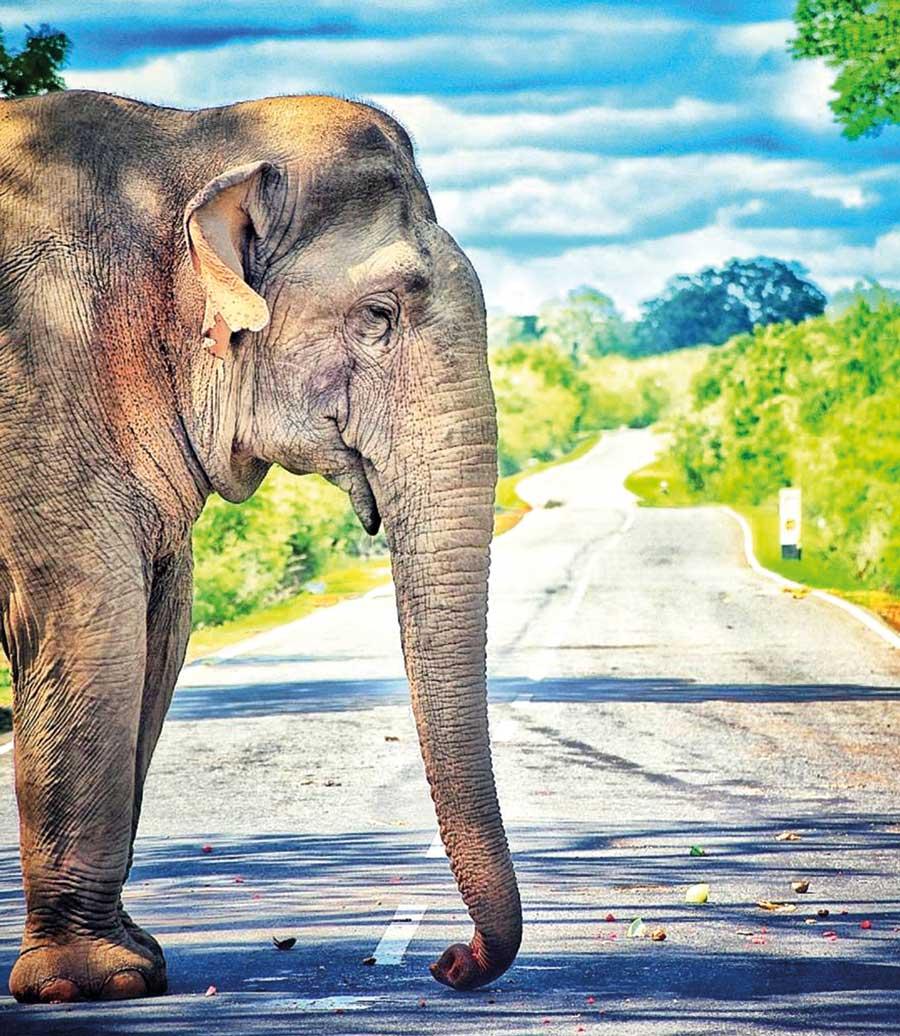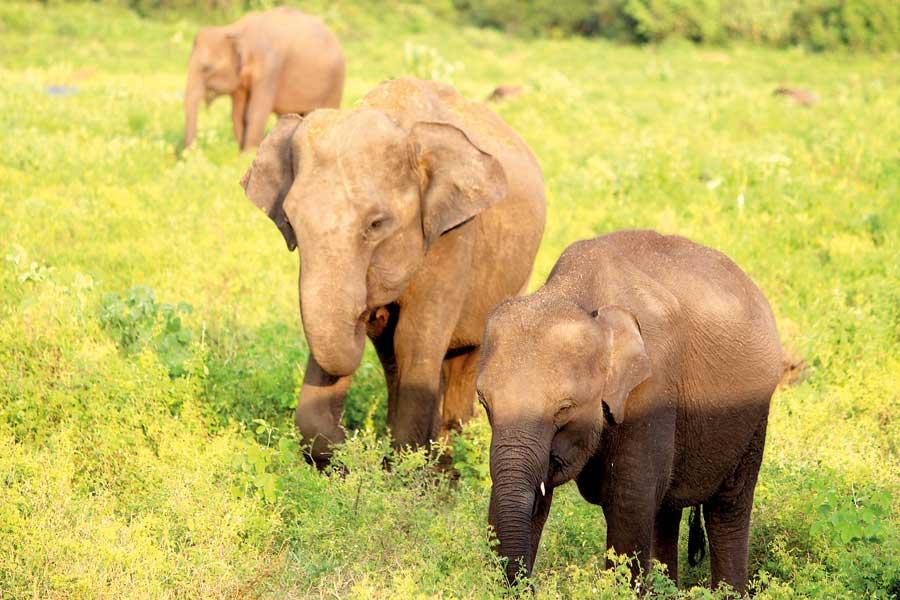Reply To:
Name - Reply Comment
Last Updated : 2024-04-19 19:28:00
A record number of elephant deaths had been reported in Sri Lanka during the past year, according to a BBC news report. Citing conservationists, the report also highlighted that it was the highest number of elephant deaths since Sri Lanka became independent in 1948.
“The human-elephant conflict has been showing signs of aggravation over the past few years,” Director-General of the Department of Wildlife and Conservation Chandana Sooriyabandara told the Daily Mirror
 “Sri Lanka has recorded an average of 300 elephant deaths in the past few years. Though not exactly surveyed, less than 6,000 is the estimated elephant population,” he said.
“Sri Lanka has recorded an average of 300 elephant deaths in the past few years. Though not exactly surveyed, less than 6,000 is the estimated elephant population,” he said.
“The human-elephant conflict gets worse by the day with multiple crops being raided, harvesting being affected, fear being inflicted in the minds of the people who are victims of the human-elephant conflict.
“Damage to both elephants and humans are on the high rise, and this is a most pressing issue to be addressed,” he said.
While much has been said and little done on elephant conservation in Sri Lanka, this article aims to find a solution to the situation of high elephant mortality as a direct consequence of the human-elephant conflict and assessing how sustainable the proposed solution would be.
When the Department of Wildlife and Conservation established the 1,000-hectare elephant holding ground in Horowpathana in 2013, there was no such establishment to be found anywhere else in the world, hence it was a trial and error experiment
A solution to aggression?
Former Director-General, Department of Wildlife and Conservation, Dr. Sumith Pilapitiya who has also worked as lead environmental specialist South Asia Region of the World Bank explained that an elephant that continuously engages in the human-elephant conflict by activities such as raiding crops, destroying harvests and human habitation and causing injury to life and property could be identified as a ‘problem elephant’. “It is not safe to either the life of the elephant or the human, that such an elephant is allowed to freely roam. Hence though may not be practised anywhere else in the world, an elephant holding ground is seen as an option, though not the ideal solution either to the elephant, the herds or the environment,” said the former Director-General who currently spends most of his time in the wild engaged in extensive elephant behaviour research.
“When the Department of Wildlife and Conservation established the 1,000-hectare elephant holding ground in Horowpathana in 2013, there was no such establishment to be found anywhere else in the world, hence it was a trial and error experiment. But with the lessons learnt from that now, we are in the process of getting the Lunugamwehera elephant holding ground ready. It is of 3,500 hectares, in the middle of the Lunugamwehera National reserve with Yala and Udawalawe national parks on either side.” Sooriyabandara elaborated.

Any lessons learnt?
Elephant behaviour expert Dr. Pruthuviraj Fernando meanwhile questions the Horowpathana experiment. “Are elephants in Horowpathana monitored? How many elephants went in? How many remain there? What has happened to those that went in? What is going on?” he quizzed. Dr. Fernando believes that only three out of the dozens of elephants who went in had been collared. “To my knowledge, the first collar was brought back to me saying it was broken off by the elephant, which I doubt; the second elephant with the collar died out of starvation, and the third called Chandi escaped the holding ground,’’ stated the concerned scientist who continued to question as to why another holding ground is necessary in Lunugamwehera when Horowpathana is available. He also questioned as to how a holding ground, thrice as big as the poorly managed ground in Horowpathana, would be effectively managed.
World Bank stepping back
Dr. Fernando stated that the World Bank which initially came forward to fund the Lunugamwehera elephant-holding ground had withdrawn from the project, while the Rs. 1,600 million will go ahead with state funding. While Sooriyabandara ascertained that the veracity of this matter, Dr. Pilapitiya who was a consultant to the World Bank and the Lunugamwehera project was questioned as to why the World Bank withdrew. “The World Bank required status reports to ascertain the feasibility of this project.
It is not safe to the life of the elephant or the human, that a ‘problem elephant’ is allowed to freely roam
Dr. Sumith Pilapitiya
These reports included:
1. Report on the environmental, and social safety status upon establishing an elephant holding ground in the specific location
2. Status reports on the fauna and flora in Lunugamwehera
3. A foreseen impact on the existing elephant population in Lunugamwehera after the proposed holding ground is established, to name a few.
These, however, were not provided during the stipulated time. Hence World Bank withdrew, as funding could not be provided without a detailed environmental impact assessment, not only on construction, but also on the given environment as well as the sensitive fact that this holding ground is being established in a national park itself”, elucidated Dr. Pilapitiya who further provided the details that Lunugamwehera National Park is contiguous with the Yala Protected Area Complex on the Eastern side which comprises Yala National Park Blocks I, II, III, IV, V, and Yala East National Park. On the western side, Lunugamwehera is connected by a jungle corridor to Uda Walawe National Park, positioning the new holding ground in a debatable position.
The contentious geographical position was questioned further by Dr. Fernando, who stated that elephants are already on the brink of starvation in Yala, while the recent uproar about the elephant Nandimitra being just one example among many. Nandimitra is a popular and frequent roamer in the Sithulpawwa area, who has on occasion known to have disturbed pilgrims visiting the area. Authorities have therefore decided to relocate Nandimitra to Horowpathana.
The first collar was brought back to me saying it was broken off by the elephant, which I doubt
Dr. Pruthuviraj Fernando
“When the national parks themselves cannot fend for the existing animals, and a holding ground is situated in the midst of it, would that not further affect the survival of the elephant population both in the national park and in the holding ground?” asked the researcher.
Sooriyabandara responded to this challenge stating that currently, preparations are underway to ensure ample water and fodder supply in the holding ground which is being built at Lunugamwehera. He deliberated that Lunugamwehera would have a ‘soft release area’ which Horowpathana does not. A soft release area according to the scientist is a compartment where the elephant that is newly recruited to the holding ground could be monitored and treated by qualified veterinary surgeons if such treatment is necessary. He also attributed the high mortality in the existing holding ground due to the elephants that are recruited already being severely wounded by gunshot, hakka patas (a modus operandi that is most popularly adapted by the villagers to crack the jaw of the elephant so that there will be gradual and severely painful death due to starvation), and poisoning which makes some of the elephants already suffering from septicemia at the time of recruitment.

Accountability
Professor of Zoology and Environmental Science of the Department of Zoology University of Colombo, Devake Weerakoon and Immediate Past President Wildlife and Nature Protection Society of Sri Lanka Rukshan Jayawardane, together with Dr. Pilapitiya and Dr. Fernando disagree that the majority of the elephants who were recruited to Horowpathana elephant ground were susceptible to death. “Reports show healthy elephants. Why were they not monitored? Why were they not collared? What happened to them? Can one just send an elephant in for the reason he is a participant in the human-elephant conflict and starve him to death? Where is the accountability?” questioned the four elephant behaviour experts in unison.
Reports show healthy elephants. Why were they not monitored? Why were they not collared?
Prof. Devaka Weerakoon
Sustainability
Development is of paramount importance. So is the safety of human beings. So is the safety of elephants, or that of any other fauna and flora for that matter. Sustainability is the equilibrium that a nation achieves in balancing all these and more sectors. To do that, certain steps could be made, perhaps easy practical steps.
As per the questions asked by scientists, when one elephant holding ground is available at Horowpathana, why is another necessary at Lunugamwehera at the cost of 1,600 million rupees? Although the argument holds that Horowpathana is only one third in capacity to that of Lunugamwehera, would not move from the latter to former be more practical with some lessons learnt and implemented at the first holding ground itself? Why was not a simple control, monitoring, an ethical measure such as collaring elephants, not done at Horowpathana over the past five years? What happened to the many dozens of elephants who were recruited? As Drs. Fernando and Pilapitiya said did they die out of starvation? If so, as Prof. Weerakoon and Jayawardane asked is there an accountability issue? Does a nation have the prerogative to imprison an animal for life on the context of aggression and then not be accountable for what follows suit? How are we as a nation responsible for the many recruited elephants and those who would be in time to come? These are questions we leave you to answer, and the way you answer them will decide how sustainable a nation we would come to be.

Sudaththa De Alwis is a freelance lawyer and a freelance journalist. She can be contacted at alwisbro@yahoo.com

Add comment
Comments will be edited (grammar, spelling and slang) and authorized at the discretion of Daily Mirror online. The website also has the right not to publish selected comments.
Reply To:
Name - Reply Comment
On March 26, a couple arriving from Thailand was arrested with 88 live animal
According to villagers from Naula-Moragolla out of 105 families 80 can afford
Is the situation in Sri Lanka so grim that locals harbour hope that they coul
A recent post on social media revealed that three purple-faced langurs near t